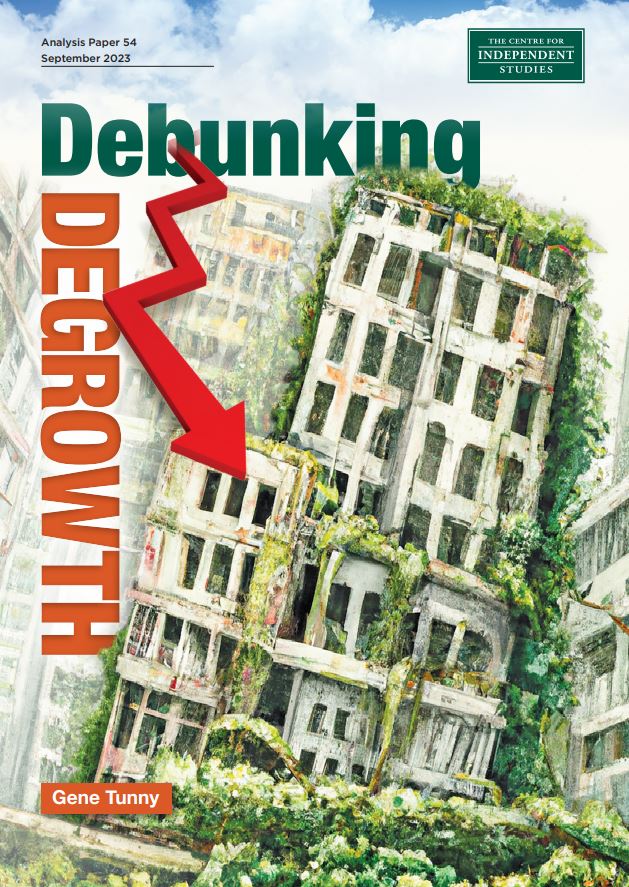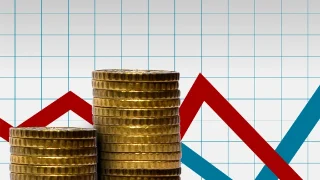
Introduction
Increasingly there are calls for degrowth, not just to abandon the pursuit of economic growth, but to shrink economies. The call for degrowth comes from environmentalists, including activists in groups such as Extinction Rebellion, and some economists, particularly in the field of ecological economics.[1] It is related to concerns about climate change, pollution, species extinction, and resource exhaustion. Economic growth is to blame, proponents say, and the proposed solution is degrowth, an aggressive contraction of economic activity that requires an acceptance of significantly lower living standards.
The degrowth movement is not just a fringe movement. It is gaining attention worldwide, has international conferences dedicated to it, and tenured academics are supporting or contemplating degrowth.[2] For example, the University of Sydney’s Professor Manfred Lenzen has modelled degrowth as a climate change mitigation strategy, and, along with co-author Lorenz T. Keyßer has concluded “degrowth pathways should be thoroughly considered.”[3] Furthermore, books preaching degrowth are gaining widespread attention. The Financial Times’ Martin Wolf selected Jason Hickel’s Less is More: How Degrowth Will Save the World as one of the newspaper’s “Best Books of 2020: Economics” — although Wolf at least observed “this programme is neither a plausible nor an effective way to respond to the imminent climate crisis.”[4] More recently, in August 2023, the New York Times profiled so-called ‘degrowth communism’ proponent Kohei Saito, a University of Tokyo philosophy professor and author of Capital in the Anthropocene.[5]
While its origins may have been altruistic, its impact on society would be devastating. It would require restrictions on personal freedoms, as well as the aforementioned lower living standards. These could only be enforced by an authoritarian government — a serious curtailment of the principles of capitalism, free markets, and a liberal democracy.
This paper first reviews the arguments for degrowth and then dissects them, addressing several myths which appear to drive this call. The paper then considers what would likely happen if a degrowth agenda were adopted. Finally, the paper considers how policy advisers and policy makers should think about economic growth and whether the calls for degrowth should be heeded.
The Degrowth movement
The main proposition behind the degrowth movement is that economic growth is causing irreversible and irreparable harm to the planet, to the detriment of future generations and potentially risking human civilisation.[6] Degrowth is described as “a planned reduction of excess energy and resource use to bring the economy back into balance with the living world in a safe, just and equitable way”.[7]
Degrowth proponents such as Jason Hickel and Tim Jackson argue that the decoupling of economic development and resource use is a myth, although they acknowledge the intensity of energy use per dollar of GDP has fallen over time.[8] Thinkers adjacent to the degrowth movement include Bill Gates’s favourite economist Vaclav Smil, who has written a fascinating book Growth which does not necessarily call for degrowth but raises questions about humanity’s continued ability to extract and use material resources. Also, relevant is Robert Ayres, a physicist and economist, who has undertaken modelling of the relationship between material inputs, energy, and the economy, and given how much we have already exploited materials and the laws of physics, concludes “the ‘engine’ of growth is running out of steam”.[9] Degrowth proponents go further than this and argue that if we do not degrow we risk ecosystem and hence economic and social collapse.
Arguably, degrowth is not a new idea. In a famous 1966 article “The Economics of the Coming Spaceship Earth”, economist Kenneth Boulding urged economists to take seriously the constraints on economic growth and that a future economy needed to be a steady state one which maintained stocks of resources for future generations.[10] Boulding’s analysis was the precursor to the circular economy movement. According to a prominent non-profit promoting a circular economy:
The circular economy is a system where materials never become waste and nature is regenerated. In a circular economy, products and materials are kept in circulation through processes like maintenance, reuse, refurbishment, remanufacture, recycling, and composting.[11]
However, the circular economy movement does not go far enough for degrowth proponents, who argue that there is no way to reconcile our current standard of living with planetary constraints.
I now consider some conjectures associated with the degrowth movement. At best these conjectures are unproven and at worst they are myths or value judgments. These claims include:
- We need to degrow to stop climate change;[12]
- We need to degrow to stop environmental degradation and biodiversity loss;[13]
- We’re rich enough already and more economic growth won’t help us; [14]
- We need to drastically redistribute income from the rich to the poor, within and between countries, to reduce the inequality associated with capitalism and to help save the planet;[15] and
- We need to degrow to avoid economic and social collapse.[16]
Following a review of these different claims, the policy implications of the degrowth agenda are considered.
Unproven claim 1: We need to degrow to stop climate change
The Intergovernmental Panel on Climate Change (IPCC) does not call for degrowth. Projections of the world responding to climate change do not show contracting economies, although they may show lower growth rates than otherwise. For example, Treasury modelling undertaken for the Gillard government in 2011 reported that, in its core policy scenario, average annual real national income growth would be one-tenth of one percentage point lower than otherwise. Real gross national income per capita would grow at 1.1 per cent over the four decades to 2050.[17]
However, more recent economic modelling attempts to demonstrate a negative impact on future real GDP growth of climate change, in the absence of strong mitigation measures, and may also include a positive productivity gain from technological advances to deal with climate change. For example, the Australian government’s most recent analysis of the transition to net zero greenhouse gas emissions (GHG) projects the Australian economy will be over two times larger (in real terms) by 2050 in a scenario where we take action to achieve net zero.[18] Indeed, the expansion would be slightly lower if no action is taken, as assumptions are made about how climate change may adversely impact the economy in the absence of GHG mitigation worldwide.
Climate change is one of the great unknowns, admittedly. Concerns have been heightened in 2023 with statistically unusual declines in Antarctic sea ice extent. In February 2023, the US National Oceanographic and Atmospheric Administration noted several more years of data were required to determine whether the record decline of Antarctic sea ice over the southern hemisphere Summer 2022-23 was due to climate change.[19] One major challenge is that the satellite record of Antarctic sea ice only dates back to late 1978. At the time of writing, it appears NOAA has not yet commented on the record low sea ice extent during the recovery phase in Winter 2023, so it is unclear whether it has changed its assessment.
Much of the alarm behind Extinction Rebellion and other climate activists relates to worst-case scenarios from numerical climate models. We have no way of knowing whether these scenarios are at all plausible and hence they should not influence public policy. As leading climate scientist Judith Curry has observed: “Our current inability to provide meaningful probabilities of future climate outcomes implies that we are in the regime of scenario uncertainty or deep uncertainty.”[20] Other prominent critics of climate change alarmism, for similar reasons, have included former Obama administration Under Secretary for Science Steven Koonin and Copenhagen Consensus Centre President Bjorn Lomborg.[21]
To argue for degrowth to deal with climate change is to discount the role that climate change mitigation measures and technological change can play in dealing with the challenges. Given the massive focus on climate change as a challenge and huge sums invested in R&D in renewables and clean technology, there are some grounds to be optimistic about technological change helping the planet rapidly decarbonise. Leading sustainability expert Wayne Visser, of Antwerp Management School and the Cambridge Institute for Sustainability Leadership, has written in his book Thriving:
… we see history repeating itself, with the so-called experts underestimating the powerful convergence of changing economic models, societal norms, environmental conditions, technology advancements, and human capacities, which are going to flip our global system toward ubiquitous sustainable technology within 10 years…
Simultaneous rapid advances in artificial intelligence, batteries, electric vehicles, and renewables are showing convergence in real time. All these, as well as other solutions that will allow us to thrive, are going to be adopted much more quickly than the incumbent leaders of business and government expect, not because the technologies are new but because they are converging.[22]
Certainly, this may be overly optimistic, but it is a good antidote to the pessimism of the degrowth proponents.
Unproven claim 2: We need to degrow to stop resource depletion, environmental degradation and biodiversity loss
This is a separate claim from claim 1, because degrowth proponents believe that the planet is still headed for ‘ecological disaster’ even if we transition to net zero.[23] Without denying the reality of endangered species and species that have become extinct due to humans, such as Tasmanian tigers or passenger pigeons, this claim is alarmist. And even it was true, it would be incorrect that degrowth is the right strategy to correct course.
Conservation efforts aimed at protecting biodiversity are increasing worldwide, and in the last decade appear to have had some success in arresting the decline since 1970, at least measured by the Living Planet Index, which tracks wildlife populations (Figure 1). Indeed, as Our World in Data reports, based on the Living Planet data, “Not all animal populations are in decline; around half have increasing numbers.”[24]
Figure 1. Living Planet Index, World
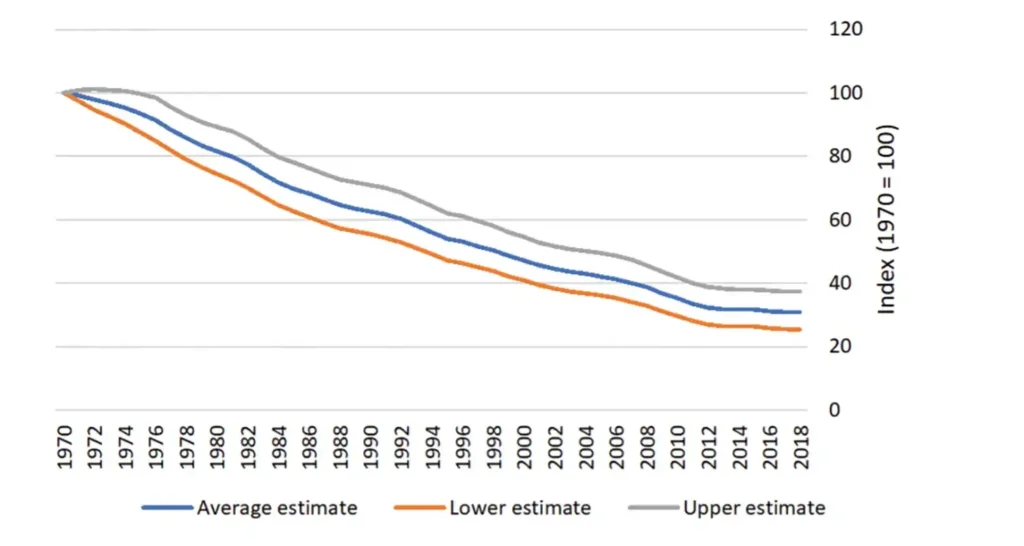
Source: World Wildlife Fund (WWF) and Zoological Society of London.[25]
Australia has extensive federal and state environmental protection laws, which encompass a wide range of regulatory levers. Furthermore, our levers of environmental protection have been extended to biodiversity in recent years and biodiversity offset schemes have been established by various Australian governments.[26]
Broadly speaking, wealthier economies have better environmental outcomes, after experiencing worsening outcomes in the initial phase of economic development. This is a phenomenon known as the Environmental Kuznets Curve (EKC), although the evidence on the curve is “mixed” as Nobel laureate William Nordhaus has described it.[27] There does appear to be an EKC for greenhouse gas emissions per unit of GDP, but there is EKC for particulate matter, which moves only in the downward direction as economic development increases.[28] Incidentally, there is strong evidence that democracies have cleaner air, and Nordhaus concludes: “the evidence supports the pro-environment nature of democratic institutions”. This is an important lesson. One of the greatest environmental tragedies of the 20th century, the degradation of the Aral Sea in the Soviet Union, occurred on the watch of an authoritarian regime.[29]
Ultimately, the perceived link between economic growth and environmental degradation underpinning the degrowth view is misguided. As Treasury observed in its 1973 Economic Growth: Is it worth having? paper:
… the premise that increases in output of goods and services must necessarily be accompanied by corresponding increases in pollution is mistaken. Relationships between output and pollution can readily be changed if society has the will to do so. Such changes can make a far greater contribution to reducing pollution than measures designed to halt or slow down the rate of economic growth.[30]
Robert Solow made a similar point that same year, that excessive pollution and environmental degradation are by no means an unavoidable accompaniment to economic growth, but a result of “an important flaw in the price system”.[31] In some cases, as was the case with, chlorofluorocarbons (CFCs) and other chemicals damaging the ozone layer, there is a clear low-cost response and the solution is straightforward — through the 1987 Montreal Protocol by which 197 countries agreed to phase out the chemicals.[32] In other cases, measures such as corrective taxation or emissions-trading schemes can be implemented to address that flaw. Throttling the economy so it degrows would be the wrong way to go about it.
Certainly, wealthier countries are better placed to engage in conservation measures. A 2021 study of extinction risk published in the leading journal Diversity and Distributions found the higher GDP was in an area, the greater the risk to threatened species, measured by the Index of Threat (IoT), but it “found substantial variation in the congruence of IoTs with anthropogenic pressures for species of different kingdoms, life-forms, threat categories and regions”.[33] This suggests that the relationship is not guaranteed, and a range of factors including better management and enforcement can play a role. Indeed, the researchers acknowledge that some outcomes are better in areas with higher GDP:
…countries with a high GDP have the resources to impose better biosecurity measures and to manage invasive animals. So, while economic development has resulted in increasing numbers of threatened species, it could also provide the financial resources required for biosecurity and conservation.[34]
Of course, there may be concerns about lower levels of environmental protection in emerging or developing economies. This is a complex issue beyond the scope of this paper. Economists would suggest that a lack of clearly defined property rights leading to the tragedy of the commons is often a problem. This is borne out by experience. For example, rainforest conservation efforts in Brazil have been hampered by “lawlessness”, as reported by The Economist.[35]
Finally, in this section, we can quickly dispense with claims regarding resource depletion. Broadly speaking, higher prices encourage conservation of resources and new exploration. Resource depletion is a poor argument for degrowth. The notorious Simon-Ehrlich wager on commodity prices is well known, with Ehrlich, predicting higher commodity prices by the end of the 1980s, having lost the bet to economist Julian Simon.[36] Ehrlich, the author of the Population Bomb, was also famous for forecasting collapsing global population as early as the late 20th century. Of course, the record has been of expanding population, having doubled from 4 billion in 1975 to more than 8 billion today. Furthermore, concerns about peak oil in the years prior to the financial crisis proved misplaced. Global oil production has continued to trend upwards since the peak oil hypothesis was advanced in the 2000s, with annual global output now more than 4 billion tonnes, compared to 3½ billion in the first decade of the century.[37]
Unproven claim 3: We’re rich enough already
Columbia University Professor Jagdish Bhagwati has been a prominent critic of the view espoused by the degrowth movement that we are rich enough already. Economic growth should still be pursued as a goal to address the dire poverty in developing and emerging economies such as India.[38] Worldwide and particularly in east Asia, economic growth has lifted more than one billion people out of extreme poverty, particularly since the Chinese market-oriented economic reforms of the late 1970s, starting with Deng Xiaoping.[39] Certainly there is a strong correlation between per capita income levels and life expectancy at lower levels of economic development and growth is highly desirable in those economies (Figure 2).
Figure 2. Gross National Income (GNI) per capita and life expectancy by country, scatter plot with line of best fit, 2021
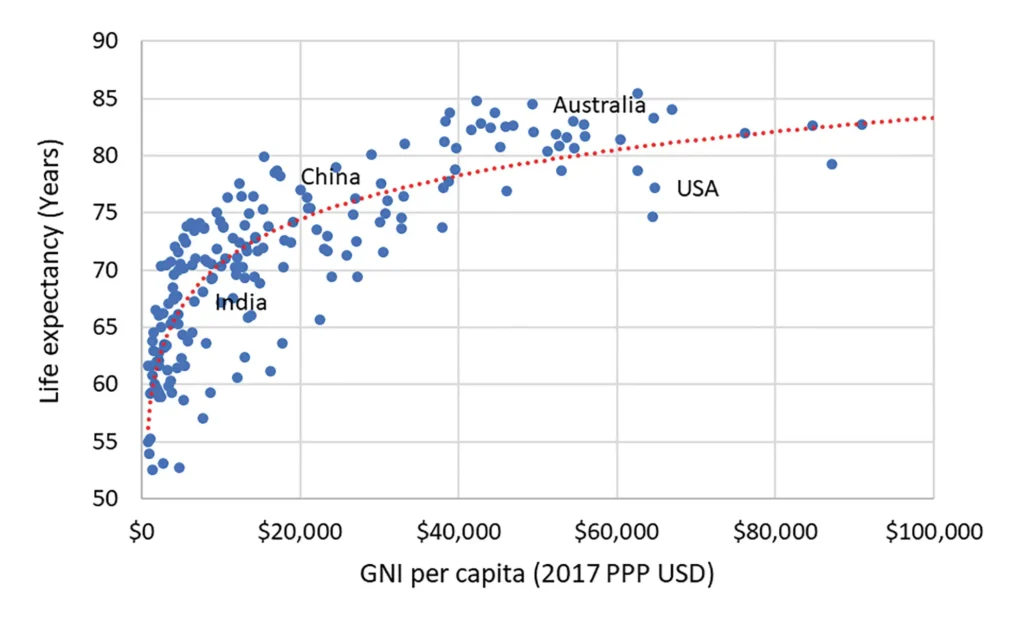
Source: United Nations Human Development Reports, https://hdr.undp.org/data-center/documentation-and-downloads. Note: The markers represent the data points for different countries. For ease of comprehension, the chart excludes Liechtenstein which is an outlier with a per capita GNI of close to 150,000 US dollars.
In his book Why Growth Matters, co-authored with Arvind Panagariya, Bhagwati makes the case for economic growth, and makes it clear economists are not naively worshiping growth at the expense of the environment:
… the liberal policy framework that has produced prosperity is not libertarian, nor is it one of “market fundamentalism”. For instance, it allows environmental objectives such as reducing domestic pollution, while proposing the use of price-based instruments, such as emission taxes instead of direct quantitative controls.[40]
This nuanced understanding of the benefits of economic growth by a leading economist demonstrates that the degrowth proponents have created a straw man economic growth proponent. For instance, Jason Hickel in Less is More: How Degrowth Will Save the World observes: “We are told that no matter how rich a country becomes its economy must keep growing, indefinitely regardless of the costs.”[41] However, there is no accompanying endnote detailing which economists, political leaders, or economic ministries have ever expressed anything so eminently silly. Degrowth is based on a misunderstanding of economics as a discipline.
In the degrowth literature, a caricature of the typical economist is presented as believing in unlimited economic growth, and that growth should be pursued regardless of its environmental impact. This is a straw man. It would be a naïve economist who did not recognise that constraints exist. And economists usually limit their projections to a few decades to come, rather than to the infinite future, in which they supposedly believe in unlimited exponential economic growth. Certainly, there are theoretical economic growth models which portray the possibility of exponential growth into the infinite future, but economists have had enough common sense not to assume stylised theoretical models are the be-all-and-end-all when it comes to public policy.
Consider the nuanced understanding of the issues the Australian Treasury presented in its 1973 paper Economic Growth: Is it Worth Having?, which was a response to the Club of Rome’s Limits to Growth report. Treasury wrote:
… economic and social policies should not be directed towards achieving any particular statistical rate of growth in the longer-run, but rather to the efficient use of available resources to establish and maintain those patterns of production and distribution which conform most closely to the preferences of the community … to set up a longer-term target rate of growth in G.D.P. — whether that rate be a high one, or as some are now advocating, a ‘zero’ rate — is to miss the point. The criteria for decision-making must be related not to the achievement of a pre-ordained statistical result but to the desires of the community, as expressed by people in their capacities as consumers, workers and electors.[42]
Notably, the Treasury in 1973 did not expect anyone would seriously advocate for negative economic growth, as is being done today.
Furthermore, the founder of modern economic growth theory and empirics, Nobel laureate Robert Solow, also showed a nuanced understanding, in criticising the Limits to Growth analysis:
I hope nobody will conclude I believe the problems of population control, environmental degradation, and resource exhaustion to be unimportant, or that I am one of these people who believe that an adequate response to such problems is a vague confidence that some technological solution will turn up. On the contrary, it is precisely because these are important problems that public policy analysis had better be based on sound and careful analysis.[43]
Regarding the data in Figure 2 above, admittedly there does not appear to be any noticeable trend above a reasonable per capita income which may encourage degrowth proponents. For instance, Jason Hickel argues: “It’s high-income countries that are the problem here, where growth has become completely unhinged from any concept of need and has long been vastly in excess of what has been required for human flourishing.”[44] The author is making a strong value judgment, of course. Who is he to say what is required for human flourishing? And how would he bring about degrowth in the advanced economies? As discussed later in the paper, the implications for liberty are harrowing.
Unproven claim 4: We need to degrow to reduce inequality
Degrowth proponents tend to see rising inequality as a feature of capitalism. For example, Co-President of the Club of Rome Sandrine Dixson-Decleve, in her testimonial for Tim Jackson’s Post Growth, observed: “either we continue to propagate a capitalistic growth paradigm that fosters inequality, climate and health crises or we build our lives and livelihoods around a holistic system providing what is truly meaningful”. Incidentally, as with other statements by degrowth proponents, there is a clear value judgment here regarding what is meaningful. Presumably the freedom that underpins capitalism in advanced economies is not considered meaningful. In contrast, Nobel Prize-winning economist (and intellectual godfather of the CIS) Friederich Hayek argued that “Liberty is not merely one particular value … it is the source and condition of most moral values. What a free society offers to the individual is much more than what he would be able to do if only he were free.”[45]
Furthermore, the concerns expressed by commentators such as the Club of Rome’s co-president quoted above seem overly focused on the increase in inequality seen in advanced economies and ignore the huge gains in living standards seen in emerging economies — i.e., the more than one billion people lifted out of extreme poverty in recent decades mentioned above. These gains have seen the relative measure of global income inequality, measured by the relative Gini coefficient, decline from 0.739 in 1975 to 0.631 in 2010.[46] This is according to an authoritative study by researchers at the United Nations World Institute for Development Economics Research and Nuffield College, Oxford. At the same time as relative inequality increased, measures of absolute inequality, based on the standard deviation of incomes, has increased because of the relatively disproportionate growth of higher incomes. Arguably, we should be more impressed by the decline in relative inequality due to bringing over a billion people out of extreme poverty than the increase in absolute inequality, but that is a value judgement, of course.
Addressing inequality is part of the degrowth paradigm. Indeed, in Hickel’s formulation, the reason advanced economies will be able to accept much lower per capita GDPs is because he envisages massive redistribution which he argues the high degree of income inequality allows.[47]
Evidence on a Kuznets curve regarding inequality is not strong. Thomas Piketty has argued solidly against it, particularly given data for the US which showed increasing inequality since the 1970s.[48] Technological change has a significant impact on inequality, as does government policy. The Kuznets curve is probably not a reliable phenomenon. That said, Japanese economist Tatsuyuki Ota has criticised Piketty for not considering the Asian experience.[49] Ota’s analysis revealed there is some evidence of the Kuznets curve for both environmental outcomes and inequality, but the relationship is much less reliable for higher income countries. Clearly policy choices are relevant. Ota wisely observes:
While environmental and income policy is often non-existent for low-income countries, high-income countries have generally introduced varied policies to cope with growing income inequality and environmental degradation.[50]
The clear message is that, while economic growth is not guaranteed to reduce inequality as the Kuznets curve would suggest, wealthier societies are better positioned to redistribute income as well as deal with environmental and other challenges.
Unproven claim 5: We need to degrow to avoid economic and social collapse
The degrowth movement is the modern incarnation of the Limits to Growth school of the 1970s, in arguing that, if extreme measures are not taken, we risk economic and social collapse, whether because of climate change, species extinction, ecosystem failures, extreme inequality, et cetera. Like the Limits to Growth analysis, and Robert Solow’s 1973 critique of that work, its conclusions follow closely from the assumptions it is making, particularly those regarding fixed resource constraints, a lack of price responses leading to resource conservation, and pessimism regarding humanity’s ability to solve our problems through innovation.[51]
In a widely publicised 2021 study, Dutch econometrician Gaya Herrington concluded that the Limits to Growth World3 model of Meadows and Forrester had produced accurate forecasts of major variables up to the present day. She wrote: “Empirical data comparisons since then [i.e. 1972] indicated that the world was still heading for collapse” by the end of this century, and that “it’s almost, but not yet, too late for society to change course”,[52] Graphical depictions of simulations show the model predicting industrial output and global population peaking and then starting to collapse between 2000 and 2050, with global output and population to be small fractions of their peaks by 2100.[53]
Experience with forecasting models suggests that we should not be impressed by the World3 model having tracked key variables to date, given that is like extrapolating existing trends. The real test of the model is whether its predictions of precipitous declines in output and population are borne out. Economic forecasters well know that the trend is not the really difficult thing to predict. It is the turning points which are extremely difficult to envisage.[54] That will be the true test of the Limits to Growth analysis.
Very likely the global economy will continue to grow over the rest of the century and living standards of future generations will be higher than of current generations, but of course that is not fully guaranteed. Nobel laureate William Nordhaus was part of a team that adopted multiple techniques to project GDP growth over the rest of the century, and both approaches converged on an estimate of per capita GDP growth of slightly above 2 per cent over the century. Using a Delphi methodology of asking experts, they concluded there was only a 5 per cent change of negative per capita GDP growth to 2100. The other technique suggested a much lower change of decline.[55] The upshot is that, while there is certainly a risk of bad outcomes over the rest of the century, that is very unlikely and should not be the central case in our forecasts and the basis for calling for degrowth.
Implications of degrowth
With the bulk of economic activity worldwide occurring in the private sector, achieving degrowth would require the implementation of a range of highly restrictive policy measures that would constrain private decision-making. It would require much more than the banning of gas stoves and would require central direction of how much people could work and consume. It may require restrictions on travel, such as bans on driving on certain days if your number plate has certain digits at the end, as has been done in Beijing. Climate lockdowns and 15-minute cities may be conspiracy theories for now, but it is very unlikely degrowth could be achieved without radical authoritarian policy measures, far more than what was seen during the pandemic.
And in a country with a growing population, such as Australia, a policy of degrowth would require declining employment and rising unemployment, with its related costs in social welfare and social ills such as crime and homelessness, among others. That combined with what would be unpopular authoritarian measures would heighten the risks of mass protests and social conflict.
Regarding those propositions from the degrowth movement that are value judgments, we leave those to the political process to resolve. To date, there does not appear to be anywhere near a majority of political support for degrowth in any democratic country. It has not been on the platform of any successful political leader.
The degrowth movement is unhelpful to good public policy. Robert Solow’s conclusion in 1973 about the Limits to Growth analysis — or ‘the Doomsday school’ — is equally applicable to the current degrowth movement: “It diverts attention from the really important things that can actually be done, step by step, to make things better.”[56] In that regard, the work of Bjorn Lomborg is important, as is the debate around appropriate policies to deal with externalities such as pollution, including greenhouse gas emissions, over-fishing, and the loss of biodiversity. Such policies include market-based mechanisms and enforcement of property rights, rather than authoritarian measures to degrow the economy.[57]
Degrowth would mean reversing the huge gains in average global per capita income seen in recent decades, partly due to market-oriented reforms beginning in China in the 1980s and India in the 1990s (Figure 3). The proportion of the global population living in extreme poverty has fallen from around 70 percent in the early 1990s to around 47 percent in 2022.[58] With a global population of over 8 billion today, that corresponds to over 1.8 billion people who have avoided extreme poverty, largely due to economic growth. Degrowth would mean sacrificing these gains and further gains. The average GDP per capita is still far below the level at which gains in life expectancy or wellbeing may start to peter out, so additional economic growth would arguably be highly desirable.
Figure 3. World GDP and GDP per capita, USD at constant 2015 prices
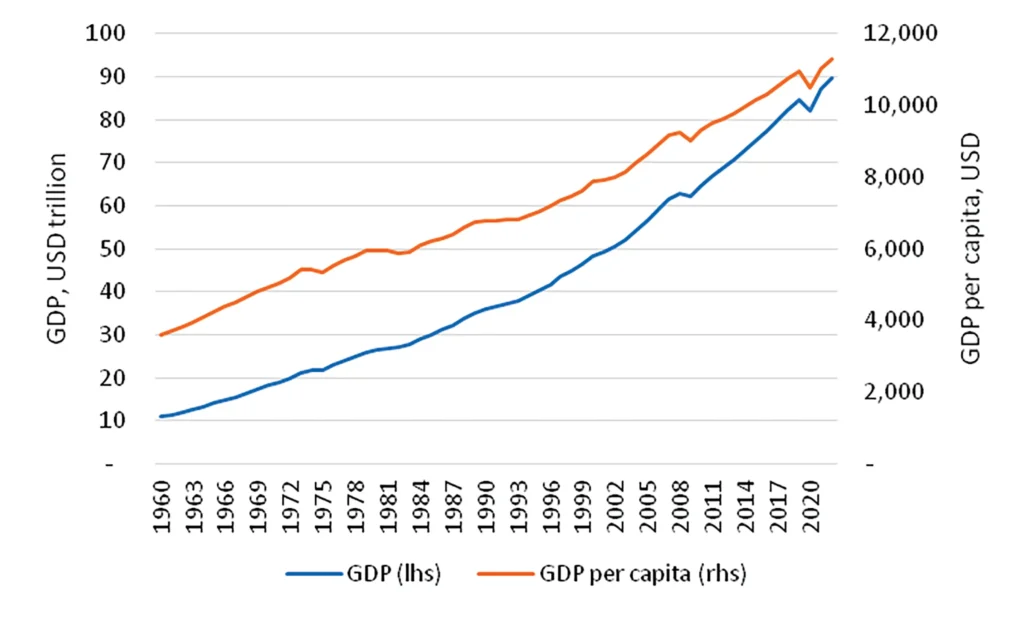
Source: World Bank World Development Indicators database.
As Robert Solow argued in 1973, and which is still true today:
The rich Western nations have never been able to agree on the principle of allocating as much as one per cent of their GNP to aid undeveloped countries. They are unlikely to share their wealth on any substantial scale with the poor countries. Even if they were, there are so many poor people in the world that an equally shared world income would be quite low. The only prospect for a decent life for Asia, Africa, and Latin America is more total output.[59]
Instead, the degrowth movement would reverse the course of economic growth due to computer simulations of Doomsday and perceived planetary constraints that have yet to stop global economic growth. It may well be that global economic growth slows down due to lower productivity growth, an argument prominently advanced by leading US productivity expert Professor Robert Gordon, but it has not happened yet.[60]
Conclusions
Currently, there is no reason to make degrowth a policy objective. Indeed, no government aims for degrowth, and is unlikely to in the future, given in practice degrowth would require vastly unpopular authoritarian measures.
Even using the degrowth propositions to argue for slower growth is questionable. Who is to say there is an optimal or target rate of economic growth? In a free society, the rate of economic growth should be determined as the outcome of the desires and actions of individuals, taking part in an economy and society with appropriate rules and regulations, of course.
Clearly, we need to respect reality and not ignore our impacts on the physical world. To give it some credit, the degrowth literature does at least remind us that the planet faces a variety of challenges, and we should avoid naïve techno-optimism about the future. That said, degrowth is based on several assumptions and conjectures which are highly suspect and lack evidence. It is based on a strawman characterisation of economists. It does not consider the role of the market mechanism in ensuring efficient resource use. It is based on computer simulations which to a significant extent assume the Doomsday they are forecasting.
Finally, it runs counter to our track record in innovation in technological progress which has pushed us beyond what were previously considered hard constraints, such as those Reverend Malthus was concerned about. Degrowth is the latest manifestation of pessimistic doom-mongering that humanity has seen many times before. Certainly, the world faces many threats, but degrowth is not the way to solve them.
Acknowledgements
The author would like to thank Ian Moore, Simon Cowan, and other CIS colleagues for helpful comments. The usual disclaimer applies, that the views expressed in this paper are the author’s and should not necessarily be attributed to anyone else.
References
Australian Government (2011) Strong Growth, Low Pollution: Modelling a Carbon Price.
Australian Government (2021a) Australia’s Long-Term Emissions Reduction Plan: Modelling and Analysis.
Australian Government (2021b) Intergenerational Report 2021.
Australian Treasury (1973) Economic Growth: Is it Worth Having?, Australian Government Publishing Service.
Ayres, R.U. and Warr, B. (2009) The Economic Growth Engine: How Energy and Work Drive Material Prosperity, Edward Elgar.
Bhagwati, Jagdish and Panagariya, Arvind (2013) Why Growth Matters: How Economic Growth in India Reduced Poverty and the Lessons for other Developing Countries, Public Affairs, New York.
Boulding, Kenneth E. (1966) “The Economics of the Coming Spaceship Earth”, in H. Jarrett (ed.) Environmental Quality in a Growing Economy, pp. 3-14, Resources for the Future/Johns Hopkins University Press.
Curry, Judith (2023) Climate Uncertainty and Risk: Rethinking Our Response, Anthem Press.
Demaria, F. (2019) “Degrowth: A Call for Radical Socio-Ecological Transformation”, Global Dialogue, vol. 9, no. 1, pp. 27-28.
Dooley, Ben and Ueno, Hisako (2023) “Can Shrinking Be Good for Japan? A Marxist Best Seller Makes the Case.”, The New York Times, 23 August 2023.
Galles, G. (2018), “18 Hayek Quotes That Show the Importance of Liberty”, FEE Stories, https://fee.org/articles/18-hayek-quotes-that-show-the-importance-of-liberty/
De Masi, P.R. (1996) “The Difficult Art of Economic Forecasting”, Finance & Development, IMF, December 1996, pp. 29-31.
Gordon, R. (2016) The Rise and Fall of American Growth: The U.S. Standard of Living Since the Civil War, Princeton University Press.
Herrington, G. (2021) Update to Limits to Growth: Comparing the World3 Model with Empirical Data.
Hickel, Jason (2020) Less is More: How Degrowth Will Save the World, Penguin, London.
Jackson, Tim (2021) Post Growth—Life After Capitalism, Polity Press, Cambridge, UK.
Koonin, Steven E. (2021) Unsettled: What Climate Science Tells Us, What It Doesn’t, and Why It Matters, BenBella Books, Dallas.
Lomborg, Bjorn (2020) False Alarm: How Climate Change Panic Costs Us Trillions, Hurts the Poor, and Fails to Fix the Planet, Little Brown.
Keyßer, Lorenz T. and Lenzen, Manfred (2021) “1.5 °C degrowth scenarios suggest the need for new mitigation pathways”, Nature Communications, vol. 12, Article number: 2676 (2021).
Nino-Zarazua, M., Roope, L. and Tarp, F. (2017) “Global Inequality: Relatively Lower, Absolutely higher”, Review of Income and Wealth, vol. 63, no. 4.
Nordhaus, William D. (2021) The Spirit of Green: The Economics of Collisions and Contagions in a Crowded World, Princeton University Press.
Ota, Tatsuyuki (2016) “Economic growth, income inequality and environment: assessing the applicability of the Kuznets hypotheses to Asia”, Palgrave Communications, DOI: 10.1057/palcomms.2017.69
Pandit, A. (2014) “How the Soviet Union Created Central Asia’s Worst Environmental Disaster”, The Diplomat, https://thediplomat.com/2014/10/how-the-soviet-union-created-central-asias-worst-environmental-disaster/
Piketty, T. (2006) “The Kuznets Curve: Yesterday and Tomorrow”, in Understanding Poverty, edited by Abhijit Vinayak Banerjee, Roland Bénabou, Dilip Mookherjee, Oxford University Press.
Radelet, Steven (2015) The Great Surge: The Ascent of the Developing World, Simon and Schuster.
Schoch, M., Kofi Tetteh Baah, S., Lakner, C. and Friedman, J. (2022) “Half of the global population lives on less than US$6.85 per person per day”, World Bank Blogs: Let’s Talk Development, https://blogs.worldbank.org/developmenttalk/half-global-population-lives-less-us685-person-day
Smil, Vaclav (2019) Growth: From Microorganisms to Megacities, MIT Press, Cambridge, MA.
Solow, Robert M. (1973) “Is the End of the World at Hand?”, Challenge, vol. 16, no. 1, pp. 39-50.
The Economist (2023) “The biggest obstacle to saving rainforests is lawlessness”, https://www.economist.com/international/2023/02/27/the-biggest-obstacle-to-saving-rainforests-is-lawlessness
Tupy, Marian and Pooley, Gale (2018) “How Julian Simon Won a $1,000 Bet with “Population Bomb” Author Paul Ehrlich”, Foundation for Economic Education, https://fee.org/articles/how-julian-simon-won-1-000-bet-with-population-bomb-author-paul-ehrlich/
Visser, W. (2022) Thriving: The Breakthrough Movement to Regenerate Nature, Society, and the Economy, Fast Company Press.
Wolf, Martin (2020) “Best books of 2020: Economics”, Financial Times, 17 November 2020.
Endnotes
[1] For example, see https://xrboston.org/action/degrowth-primer-and-discussion/.
[2] The 9th International Degrowth Conference was held in Zagreb, Croatia over 29 August to 2 September 2023; https://degrowth.info/en/conference/9th-international-degrowth-conference-planet-people-care-it-spells-degrowth
[3] Keyßer, Lorenz T. and Lenzen, Manfred (2021, p. 1).
[4] Wolf, Martin (2020).
[5] Dooley, Ben and Ueno, Hisako (2023) “Can Shrinking Be Good for Japan? A Marxist Best Seller Makes the Case.”, The New York Times, 23 August 2023.
[6] For example, see Hickel (2020, p. 18) and Jackson, T. (2021, p. 32).
[7] Hickel, J. (2020) Less is More: How Degrowth Will Save the World, Penguin, London, p. 29.
[8] Hickel, J. (2020, pp. 154-155) and Jackson, T. (2021, pp. 38-40).
[9] Ayres, R.U. and Warr, B. (2014, p. xviii).
[10] Boulding, K. (1966).
[11] https://ellenmacarthurfoundation.org/topics/circular-economy-introduction/overview
[12] For example, see Hickel, J. (2020, pp. 217-218).
[13] For example, see Jackson, T. (2021, p. 131) and Hickel, J. (2020, pp. 120-123).
[14] For example, see Hickel, J. (2020, pp. 177-178) and Jackson, T. (2021, pp. 52-53).
[15] For example, see the discussion in Hickel, J. (2020, p. 183-184) which implies the need for radical redistribution or curtailment of the consumption of the rich, or Demaria, F. (2019) which describes degrowth as a ‘Radical Socio-Ecological Transformation’.
[16] This proposition is related to the previous propositions and hence the previous references given, such as Jackson (2021) and Hickel (2020) are also relevant.
[17] Australian Government (2011, p. 1 and p. 11)
[18] Australian Government (2021a) Australia’s Long-Term Emissions Reduction Plan: Modelling and Analysis, p. 33 and p. 84 which identifies the 2021 Intergenerational Report real GDP projections as the based case for the real GDP projections in the climate change modelling. The IGR’s real GDP projections between 2020-21 and 2050-51 can be calculated based on figures in Tables A1.1 and Tables A1.2 in Australian Government (2021b, pp. 150-151).
[19] https://www.climate.gov/news-features/understanding-climate/understanding-climate-antarctic-sea-ice-extent
[20] Curry (2023, p. 119).
[21] See Lomborg (2020) and Koonin (2021).
[22] Visser (2022, pp. 33-34)
[23] Hickel (2020, p. 22).
[24] https://ourworldindata.org/biodiversity?insight=not-all-animal-populations-are-in-decline-around-half-have-increasing-numbers#key-insights-on-biodiversity
[25] The data can be accessed via https://ourworldindata.org/biodiversity?insight=on-average-there-has-been-a-large-decline-across-tens-of-thousands-of-wildlife-populations-since-1970#key-insights-on-biodiversity
[26] See for example https://www.environment.nsw.gov.au/topics/animals-and-plants/biodiversity-offsets-scheme/about-the-biodiversity-offsets-scheme
[27] Nordhaus, W. (2021, p. 155).
[28] Ibid., pp. 156-7.
[29] Pandit, A. (2014) “How the Soviet Union Created Central Asia’s Worst Environmental Disaster”, The Diplomat, https://thediplomat.com/2014/10/how-the-soviet-union-created-central-asias-worst-environmental-disaster/
[30] Australian Treasury (1973, p. 5).
[31] Solow, R. (1973, p. 49).
[32] See https://www.dcceew.gov.au/environment/protection/ozone/montreal-protocol
[33] Pouteau et al. (2021, p. 60).
[34] Ibid.
[35] The Economist (2023) “The biggest obstacle to saving rainforests is lawlessness”,
[36] Tupy, M. and Pooley, G. (2018) “How Julian Simon Won a $1,000 Bet with “Population Bomb” Author Paul Ehrlich”, Foundation for Economic Education, https://fee.org/articles/how-julian-simon-won-1-000-bet-with-population-bomb-author-paul-ehrlich/
[37] BP Statistical Review of World Energy data, accessed via Macrobond.
[38] Bhagwati, Jagdish and Panagariya, Arvind, 2013.
[39] Radelet, S. (2015).
[40] Bhagwati Arvind Panagriya (2013, Kindle location 288).
[41] Hickel (2020, p. 167).
[42] Australian Treasury (1973, p. 5).
[43] Solow, R. (1973, p. 43).
[44] Hickel, J. (2021, p. 21).
[45] Quoted by Galles, G. (2018), “18 Hayek Quotes That Show the Importance of Liberty”, FEE Stories, https://fee.org/articles/18-hayek-quotes-that-show-the-importance-of-liberty/
[46] Nino-Zarazua, M. et al. (2017, p. 671).
[47] Ibid., Kindle location 3164.
[48] Piketty (2006).
[49] Ota (2017, p. 1).
[50] Ibid.
[51] Solow, R. (1973).
[52] Herrington, G. (2021, p. 1).
[53] Ibid., p. 8.
[54] See for example De Masi (1996) regarding a review of IMF World Economic Outlook forecasts in the 1990s. This track record would not have improved since then, considering the well-known failure to forecast the 2008 global financial crisis.
[55] Nordhaus (2021, p. 79).
[56] Solow (1973, p. 50).
[57] Lomborg (2020).
[58] Schoch et al. (2022).
[59] Solow (1973, p. 41).
[60] Gordon (2016).
